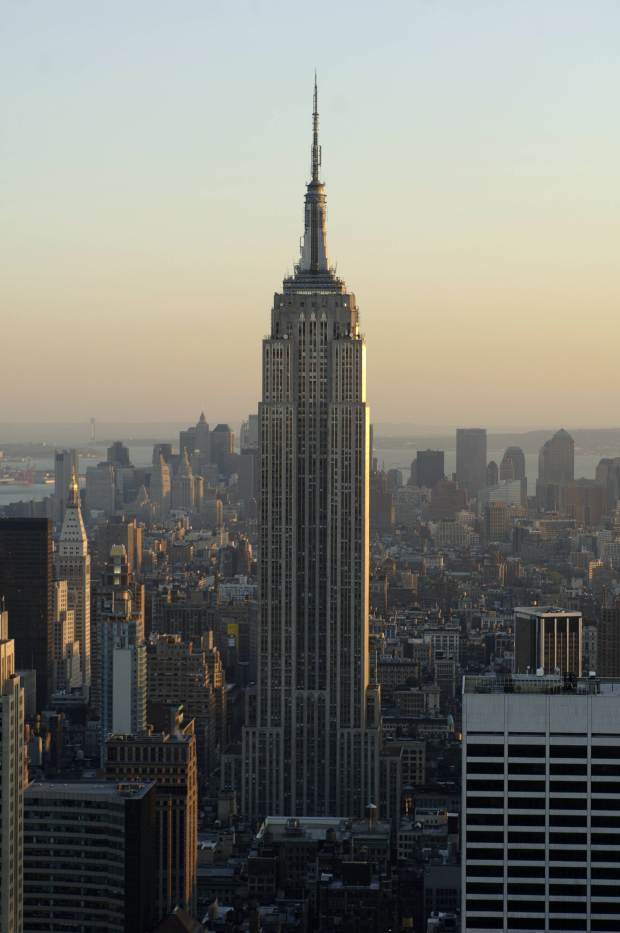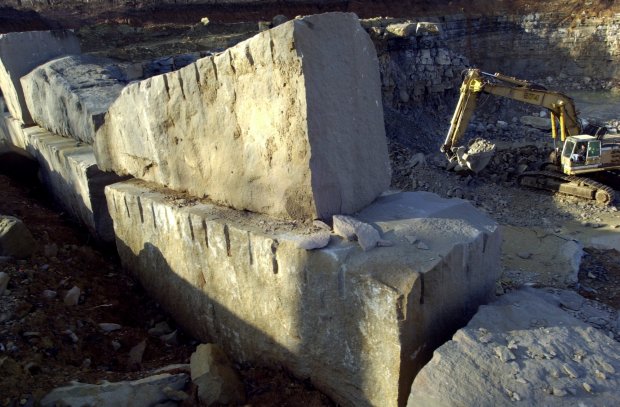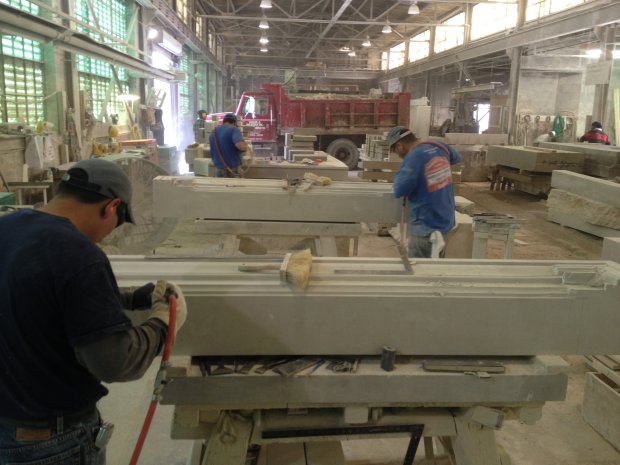[ad_1]
The rocks embedded in the exterior of Chicago’s Tribune Tower were famously collected by newspaper reporters on assignment in remote areas.
There are nearly 150 stones Parts of famous buildings around the worldIncluding the pyramids of Egypt, the Great Wall of China, and St. Peter’s Cathedral in Rome. There’s even an 1880 Chicago brick from the home of Tribune founder Robert McCormick.
But it was the limestone surrounding the famous rocks that attracted special attention recently when the tower’s owners converted the building from newspaper offices to apartment units.
The cream-coloured limestone was placed when the tower was built almost a century ago, and some parts needed repairs.
“It was in bad shape for a lot of reasons,” said Tom Van Etten of Flossmoor, co-owner of Galloy & Van Etten, a firm hired to do restoration work on the building’s stone exterior. “Mostly due to the steel support rusting and deteriorating over 100 years.”
A year earlier they had completed a similar restoration across the river at the London Warranty and Casualty building, now known as the London House Hotel, which was built using the same materials around the same time as the Tribune Tower. A third building, 333 N. Michigan Avenue, is another building from the early 1920s that flanks the Michigan Avenue Bridge, clad in the same Indiana limestone.
Both projects Van Etten’s company worked on required some of the stones to be replaced and matched so that the repairs fit seamlessly.
“You take some existing samples, cut them up to see what they are, go to Bloomington and find the best matching stone,” he said. “The beauty of Indiana limestone is that the stone they mine today is the same stone they mined 100 years ago.”
The material mined from large mineral deposits around Bedford and Bloomington, Indiana, had already become popular in the booming construction industry in the late 1890s. Van Etten’s great-grandfather, Dutch immigrant Abram Van Etten, joined the bandwagon as an 18-year-old entrepreneur when he opened his first stone store at 123rd Street and Emerald Avenue. By 1903 he was able to build his own store using Indiana limestone at 118th and Halsted streets.
“It was almost all Indiana limestone,” Van Etten said. “There were a hundred stone companies in Chicago at the time. “Everything was built from Indiana limestone.”
Kevin Harrington, professor emeritus of architectural history at the Illinois Institute of Technology in Chicago and co-author of the 2003 guidebook “Famous Buildings of Chicago,” now in its 5th edition, said the stone’s popularity is well deserved.
“It’s an incredibly beautiful stone and was used in many of Chicago’s most iconic buildings,” he said.
Beyond the prominent Michigan Avenue bridge area, there are structures in the LaSalle Street financial district anchored by the Chicago Board of Trade building, much of the Chicago Museum Campus area, Hyde Park and the Museum of Science and Industry—in nearly every area of the city. area.
His fame spread throughout the country. Less than a decade after the Tribune Tower was built, the Empire State Building in New York City was clad in Indiana limestone. Gilded age patron George Vanderbilt used the stone for his Biltmore Estate in Asheville, North Carolina.

Harrington said the limestone is part of an ancient legacy from millions of years ago when the Midwest was covered by a large inland sea that stretched from Western Ohio to Eastern Nebraska. Sea creatures have lived and died here for thousands of years and ever since the remains of their shells were compressed into the limestone.
But not all limestone is created equal.
“The high degree of lime in the stone’s shells means the quality of the stone is also high,” Harrington said.
Mined limestone Thornton, where Interstate 80 passes through a massive, man-made crater It is bright white and full of fossilized remains of cephalopods and other creatures that lived here millions of years ago.
“Everyone asks about Thornton,” Van Etten said. “It is not a good stone for construction. The building stone must have a certain durability. This stone is simply blasted and used as gravel. “It goes under the roads, but it is not used as cut stone or dimensional stone.”
Not far away in Lemont, workers digging the Illinois and Michigan Canal encountered large deposits of yellow limestone good enough for architecture. Lemont or Joliet limestone ended up in the facades of some buildings. oldest buildings in the regionLike Joliet Prison and Chicago’s Water Tower and Pump House.
But it turned out to be very fragile.
“Lemon is a loose stone. Harrington said the layers of the levee would break apart easily. “The Joliet prison, the Water Tower, these were built in the last quarter of the 19th century, before Bedford (Indiana) opened. When this happened, they realized something special was happening.
“From the end of the depression, which lasted from 1893 to 1897, to the Great Depression, there was a 35-year period in which American cities increased in population, wealth, and building numbers. “All of this contributed.”
In addition to being structurally stronger than their Lemont predecessors, the limestones in Bedford and Bloomington were also advertised as “self-cleaning.”
“Limestone as a whole is very sensitive to acid rain. Acid rain washes away the stone,” Harrington said.
Chicago relied heavily on coal mined in southern Illinois, a “soft” type that was heavy in sulfur and produced more soot than coal from other regions.
“For example, the Northern Trust bank went dark because of all the soot,” he said. “The appeal of Bedford limestone is that the chemical reaction of the rain on the soot washes it away and the stone continues to appear that soft tan or beige color. It didn’t get as dirty as most earlier stone buildings.”

The lighter color of Bedford limestone also made it a natural fit for architectural styles that have been in vogue since the White City setting of the World’s Columbian Exposition in 1893.
As economic conditions created a skyscraper boom in Chicago, “the city went from a shorter city to a taller city and from a city of dark, dark buildings to a city of much lighter buildings,” Harrington said. “Many of these buildings were connected to the classical language used at the World’s Fair.”
Even structures built in later styles, such as art deco and gothic buildings such as the Tribune Tower, incorporated the creamy appearance of Bedford limestone. But more than its color, the stone’s maintenance-free nature has made it the pavement of choice across much of Chicago’s skyline.
“When people are estimating the cost of the material, I bet the behavior and more durable quality of Bedford limestone makes it more attractive, and if it were more yellow, they would feel that way.” “I found it acceptable,” he said. “Though her lighter color only added to her appeal.
Even now, more than a century later, Harrington said he has never come across any other material that is so widely distributed and “exploited across the country.”
“You mostly build with materials you have on hand,” he said. “You know the common brick of Chicago; this is a function of the clay underlying Chicago. Above the lake in Milwaukee are Cream City bricks that are the color of the clay there. “There are cities that like to use local granite and other materials.”
Van Etten’s firm long dealt mostly with Indiana limestone, but a fire at the company’s West Pullman store in the 1980s destroyed most of its records, so he can’t pinpoint any of his earlier projects.

But he has some of the tools his ancestors used.
We have some of the same machines,” Van Etten said. “We have old planers that were made in 1900 and are no longer in production, and I believe they are still the best way to profile stone.”
In recent years, they have branched out into other stones as well. A recent contract to restore the State Capitol in Wyoming required the reopening of a long-closed quarry so they could access the Wyoming sandstone used by the original builders.
Quarries around Bloomington and Bedford remain open, even though Indiana limestone’s heyday is behind us. But Van Etten said the stone still retains the qualities that made it popular in the beginning.
“It was always under pressure from new materials that were cheaper,” he said. “But he’s endured it all and I don’t see any reason why he shouldn’t continue. “There is basically an endless supply.”
Landmarks is a weekly column in which Paul Eisenberg explores the people, places and things that have left an indelible mark on the Southland. He can be reached at: peisenberg@tribpub.com.
 Best American Comics News bestamericancomics.com started its broadcasting life on December 21, 2022 and aims to offer original content to users. Aiming to share information in technology, science, education and other fields, bestamericancomics.com aims to provide its readers with the most up-to-date and comprehensive. Since the content of the site is created by expert writers, readers are reliable and accurate referrers.
Best American Comics News bestamericancomics.com started its broadcasting life on December 21, 2022 and aims to offer original content to users. Aiming to share information in technology, science, education and other fields, bestamericancomics.com aims to provide its readers with the most up-to-date and comprehensive. Since the content of the site is created by expert writers, readers are reliable and accurate referrers.


